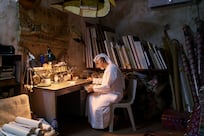Time's a funny thing. Walking on the street, eight minutes doesn't seem like a lot. But when you're underground, travelling beneath millions of tonnes of ancient, weather-withered rock, eight minutes - all 480 seconds worth - can seem like a lifetime.
So it is under Taiwan's Hsuehshan Tunnel, a 13 km-long highway that opened in 2006 and passes beneath the Snow Mountains, a natural barrier between the capital, Taipei, and the rural county of Yilan on the island's ruggedly beautiful east coast. Not only a feat of engineering that took 15 years to complete, Hsuehshan is a symbolic link between Formosa's industrialised west, home to 98 per cent of the population and the wind-whipped, mountainous east, where spirits and legends still hold sway. And it's Hsuehshan that is bringing tourists from the capital and beyond to the east, home to some of Taiwan's most spectacular natural beauty.
My journey down the island's east coast starts in the island's thriving, chaotic capital. Taipei is one of the region's trend setters, and famed for its unique culinary traditions and proud nationalistic monuments, which are juxtaposed by its mega malls and towering glass skyscrapers, including the 101, once the world's tallest building.
Having stayed at the new-design and savvy W Taipei, already a hub for the city's arts and culinary scenes, I spent my first day in the capital exploring the adjacent Core Pacific City Mall and the nearby 101 Mall, two of the city's trendiest shopping and dining spots. Both are sprawling temples to retail therapy, where crowds of eclectically clothed youth, smart phones glued to their hands, wash over the unprepared traveller in a wave of Mandarin slang and brightly coloured bubble milk tea cups.
In the warmth of the evening, I get the last of my city fix with a meal at the Jaoho night markets, known locally as Zau Ho. Located in the city's Sungshan District, near the Tsuyou Temple, here you can graze for signature Taiwanese snacks such as skewered fish balls, baked grouper and xiaochi, Taiwanese-style tapas served on little plates. The flea markets that surround the central food court are open into the early hours in this city that rarely sleeps.
Needing a reprieve from the big city, I make for Yilan, through the Hsuehshan Tunnel. After the afore-mentioned eight-minute drive, we burst out into the startling sunshine of north-eastern Taiwan. As far as the eye can see, the world is a green billiard table punctuated by a scattering of Monopoly-styled houses.
They say anything will grow in Yilan. From the risen highway, which cuts across the landscape like a concrete python, they could be right. A sea of emerald-green rice stalks, their tips flickering with the whims of the wind, reach towards the horizon, where purple mountains loom.
Visitors come to Yilan for many reasons; for a respite from the bustle of city life and for the unique dishes available in the rural villages, or to surf at Honeymoon Bay and to watch pods of dolphins and migrating whales in the shallows of Turtle Island. This is the land of the Kavalan aboriginals who, as legend has it, came one day from the sea. It was their name, which means "flatland people", that eventually morphed into "Yilan" - their folk culture is still celebrated with annual festivals.
In many ways, Yilan is a cultural time capsule. Each year, thousands attend events such as the Dongshan River Water Festival, or visit the National Centre for Traditional Arts or the Yang Shih-Fang Memorial Gardens, which opened in 2004. Dedicated to Yang, a civil servant who advocated protection of the region's unique culture, a former temple complex has been converted into an arts village where practitioners continue his dream.
Within the garden's restored temple buildings, I meet retired school teacher Chester Lim, who spends his afternoons making traditional Taiwanese lanterns from bamboo papyrus and fibres. Scores of colourful finished products in all shapes and sizes dance in the late afternoon breeze.
"It's important that we retain these traditional arts," says Lim, as he smooths out soaked pulp over a fibre frame. "We get a lot more visitors from the capital and even overseas because of the tunnel, and it's a chance to show the Taiwan that was. If we don't hold tight to these traditions, who will?" He holds up the finished lantern to a group of camera-toting visitors. "It's up to us to make sure young people still learn the old ways."
At dusk on the roof terrace at Silks Place, Yilan's first five-star hotel, a series of mineral pools set at varying temperatures prove popular with gaggles of gossiping middle-aged Taiwanese women. Submerged in steaming water, they watch the last of the day's light fade behind the mountains, the fields below falling dark and silent. They laugh as I let out a shriek after testing one cold deluge, and again when my ears turn red in the hot pool.
"It's nice to come here and remember how beautiful Taiwan can be," says one somnolent soaker, to the nodded agreement of her city friends. "We try to get down here every few months; we visit the temples and soak in the hot pools and try and find a little piece of calm. You always forget just how lovely the east is, until you return."
The next morning I rise early to tackle Yilan City on two wheels. The city has developed some serious green credentials; it has hosted green expos, attended by experts and architects from around the world, and implemented a Green Map that allows visitors to discover the best of the city's parklands, organic restaurants and environmentally friendly buildings, many of which are local government offices. Yilan City even hosts the annual Green International Film Festival, a non-competition showcase of green-themed productions.
Guides from the Silks Place take guests on complimentary bike tours alongside the Dongshan River. Wide green belts of dancing reeds on either side of the river testify to the extent of the annual flood season, as teams of dragon boaters power down the waterway to the boom of Chinese drums. Nearby, early morning walkers cross the river on a bridge entirely constructed from recycled building materials.
By noon I'm aboard a local train, racing across Yilan's vast green plateau, before diving into the mountains again, emerging minutes later closer to the sea, the train traversing a sliver of land between the wind-whipped ocean and towering peaks, lush with a persistent drizzle.
I leave the rails in the east coast city of Hualian, heading north on the Suao-Hualien Highway to take in the grandeur of the Qingshui Cliffs, 5km of towering bluffs that slide dramatically into the ocean, before delving into the Taroko Gorge.
The Gorge is one of Taiwan's best kept secrets. Nestled in the heart of the Taroko National Park, the 19km-long canyon is the ultimate testament to the powers of nature. For 70 million years, rushing alpine rivers have worn down layers of marble to create an awe-inspiring geological landscape of mile-high cliffs.
Taroko, and man's miniscule impact on it, is inspiring. Nationalist soldiers retreating from the civil war in China were put to work carving a road through the living rock by hand. The result now whisks visitors from sea level up to 3,400m and some of Taiwan's tallest peaks, all within the space of 60km.
At the gorge's heart is Silks Place Taroko. Once the site of the famous Tian Hsyang alpine lodge and a favourite haunt of Asia's power brokers, the hotel's modern, minimalist rooms offer visitors the chance to view the canyon's waterways, shrines, and nearby Tiansiang Convent in comfort.
I spend the evening soaking in one of the hotel's outdoor hot pools under an awe-inspiring canopy of stars and to a chorus of insect calls from the bush-clad mountains. Although the hotel boasts fine restaurants, a lavish day spa and nightly cultural performances, most visitors come to enjoy the silence.
At day break I set out to explore the gorge. It's an easy downhill walk from the hotel, across the Cihmu Bridge to the Tunnel of Nine Turns, one of the route's most impressive engineering feats. Joining groups of mainland Chinese tourists, all toting white hard hats to protect against falling rocks, I follow a path between two cliffs, the space narrowing to less than 10m at some points. Below, the waters of the river are turquoise, frothing as they tumble through boulders worn smooth by the elements.
At the Swallow's Grotto, birds flutter on the thermals and nest in natural pockmarks in the cliff face. Many walkers also continue down to the Eternal Spring shrine, which looks out over a picturesque waterfall, but I choose to tackle the gorge in the darkness of night with one of the hotel's night-time bike tours. Despite being strung with more lights than a Christmas tree, the darkness is like a vacuum, the silence when we pause along the way, all but deafening.
I chat with my guide, a fit young Chinese woman for whom the hills back to the hotel offer little challenge, about city life. She sits back in her saddle, looks up at the stars and mutters with a smile: "most people don't know what they're missing." Thanks to a tunnel that links a once divided people, all that is about to change.
If you go
The flight Return flights with Cathay Pacific Airways (www.cathaypacific.com) to Taipei from Abu Dhabi via Hong Kong cost from Dh3,820, including taxes.
The hotel Double rooms at W Taipei (www.www.starwoodhotels.com; 00 886 2 7703 8888) cost from US$283 (Dh1,040) per night. Silks Place Yilan (www.silksplace-yilan.com.tw; 00 886 3 935 1000) has double rooms from $196 (Dh719). Silks Place Taroko (http://taroko.silksplace.com.tw; 00 886 3 869 1155) has double rooms from $275 (Dh1,010). Prices include breakfast and taxes.




